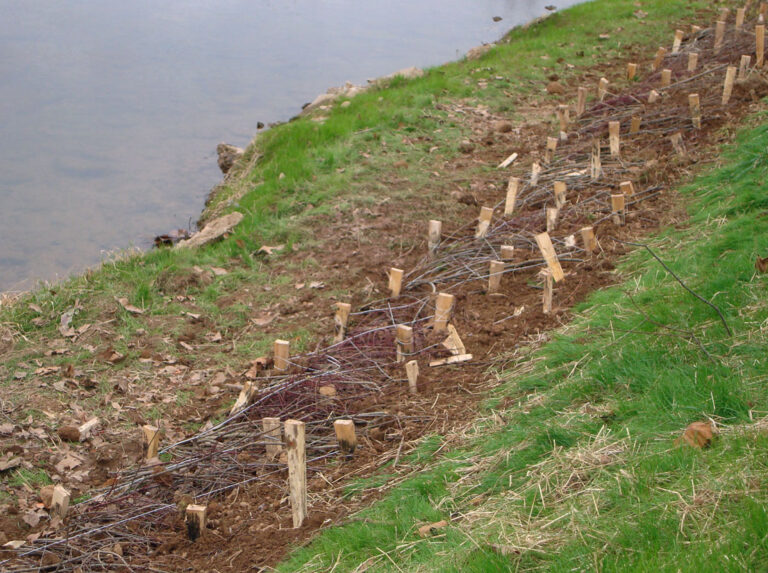Soil erosion is a significant challenge in conservation, particularly in areas where steep slopes, streambanks, or disturbed lands are exposed to wind and water. Left unchecked, erosion can degrade ecosystems, disrupt waterways, and threaten native plant and animal species.
One effective method for stabilizing these vulnerable landscapes is brush layering, a natural erosion control technique that reinforces slopes using live plant material.
Brush layering is widely used in land restoration and conservation projects, particularly in the Northeastern United States, where fluctuating water levels, heavy rainfall, and human activity contribute to ongoing soil instability. This method strengthens slopes while promoting vegetation growth and habitat recovery.
What is Brush Layering?
Brush layering is a soil bioengineering technique that stabilizes slopes by embedding live woody cuttings into the soil. The branches are placed in layers along the contour of a slope, where they take root, reinforce the soil, and reduce surface runoff. Over time, these plants establish a strong root system that further stabilizes the site.
Brush layering is commonly used in streambank restoration, slope stabilization, and habitat rehabilitation projects.
By combining engineering principles with ecological restoration, brush layering provides a long-term solution for preventing land degradation while enhancing biodiversity.
Why is Brush Layering Important for the Northeastern U.S.?
The Northeastern United States faces significant challenges related to soil erosion. Heavy precipitation, seasonal flooding, and human development all contribute to land instability. Brush layering is especially beneficial in this region because it:
- Reduces sediment runoff into rivers and streams.
- Restores riparian buffers that protect water quality.
- Creates habitat for pollinators, birds, and aquatic species.
When implemented correctly, it mimics natural stabilization processes, making it a highly sustainable approach to erosion control.
Brush Layering Techniques
Brush layering can be implemented in several ways, depending on site conditions and restoration goals.
Common Brush Layering Techniques
The most widely used techniques include:
- Brush (Branch) Layers: Live branches are placed in horizontal layers within the soil to stabilize slopes and encourage root growth.
- Brush Mattresses: A dense network of overlapping branches is secured to the soil surface, forming a mat that prevents erosion while promoting plant establishment. Commonly used along stream banks.
- Wattles (Fascines): Bundles of live cuttings are arranged in trenches along a slope. These structures help slow water runoff and reduce surface erosion while the plants take root.
The right choice will depend on site-specific factors such as slope angle, soil composition, and water flow patterns.
Preparing a Site for Brush Layering
Before installation, careful planning is required to ensure the long-term success of a brush layering project:
- Site Assessment: (More on this later.)
- Material Collection: Harvest live, dormant cuttings from suitable native species (discussed in the next section). Ensure cuttings are of appropriate size and condition.
- Excavation and Bench Preparation: Create horizontal benches or trenches along the contour of the slope. These structures provide support for layering and improve soil-root contact.
- Placement and Securing: Arrange cuttings in layers, ensuring the basal ends are embedded in the soil for maximum rooting potential. Secure layers with additional soil and erosion-control fabric if needed.
- Watering and Soil Compaction: Apply water to promote root establishment and compact the soil to minimize air gaps around the plant material.
What Plants Work Best for Brush Layering?
Selecting the right plant species is critical for a successful brush layering project. The best plants are those that root easily, tolerate erosion-prone conditions, and thrive in the local climate.
Best Plant Species for Brush Layering
Commonly used species include:
- Silky Willow (Salix sericea) – Excellent for brush layering due to their rapid root development, adaptability to wet soils, and ability to stabilize streambanks.
- Dogwoods (Cornus spp.) – Pagoda Dogwood (Cornus alternifolia) also provides habitat benefits for wildlife.
- Buttonbush (Cephalanthus occidentalis) – Buttonbush is well-suited to wet environments and effective at stabilizing soils while also supporting pollinators and other wildlife.
- Ninebark (Physocarpus opulifolius) – Thrives in a range of soil conditions and offers additional ecological benefits, such as pollinator support.
If you’re uncertain about your project, check out our seed finder or contact the experts at Ernst for help.
Matching Plants to Site Conditions
Choosing the right species depends on site characteristics and project goals:
- Moisture levels: Willows thrive in wet environments, while ninebark and some dogwoods tolerate drier conditions.
- Slope stability: For steep slopes, plants with aggressive root growth (e.g., willows and dogwoods) are preferred.
- Ecological function: If the goal is habitat restoration, select species that provide food and shelter for wildlife in addition to soil stabilization.
Using a mix of species can enhance project success by improving biodiversity and ensuring different plants fill complementary roles in the landscape.
Considerations and Best Practices for Brush Layering
Careful site assessment, proper installation, and ongoing maintenance are all critical factors in ensuring long-term stability and ecological benefits.
Evaluating Conditions Before Installation
Before beginning a brush layering project, it’s essential to analyze the site to determine feasibility and select the best approach. Key factors to assess include:
Slope Stability
Brush layering is most effective on moderate to steep slopes but may require additional stabilization methods, such as rock toe protection, in highly eroded areas.
Soil Type
Loose, well-draining soils encourage root establishment, while compacted or sandy soils may require amendments for better plant survival.
Moisture Levels
Consistent soil moisture is necessary for cuttings to root successfully. If the site is too dry, supplemental irrigation may be needed.
Existing Vegetation
Understanding current plant cover helps determine whether additional site preparation is necessary, such as removing invasive species or competing vegetation.
Best Practices for Installation
To maximize the effectiveness of brush layering:
- Use freshly cut, dormant branches: Harvest plant material during the dormant season (late fall to early spring) to increase survival rates.
- Align layers with the natural slope: Install brush layers along contour lines to ensure proper drainage and prevent runoff from eroding the site.
- Ensure good soil contact: Pack soil tightly around branches to eliminate air pockets and promote root establishment.
- Secure layers properly: Use erosion control fabric or biodegradable matting on steep slopes to hold soil in place while plants take root.
Each of these steps improves the overall stability and effectiveness of the brush layering system, ensuring that it integrates naturally with the surrounding environment.
Maintenance and Long-Term Management
After installation, continued monitoring and maintenance are essential to ensure success. Key tasks include:
- Regular inspections: Check for signs of erosion, plant die-off, or displacement, especially after heavy rainfall.
- Weed and invasive species control: Competing vegetation can hinder establishment, so periodic removal may be necessary.
- Supplemental watering: In dry periods, providing additional moisture can improve survival rates, particularly in the first growing season.
- Reinforcement as needed: If sections of the site become unstable, additional plant material or erosion control measures may be required.
Proper planning, execution, and maintenance will ensure that the system remains functional for years to come.
Get the Most out of Your Brush Layering Project: Partner with Ernst
Brush layering is a proven bioengineering technique that stabilizes slopes, prevents erosion, and restores natural habitats using live woody cuttings.
Successful implementation depends on choosing the right technique, selecting suitable plant species, and preparing and maintaining the site properly. When done correctly, brush layering not only reinforces the landscape but also supports native ecosystems.
If you’re ready to start your brush layering project, or if you have questions that this guide didn’t answer, the experts at Ernst are ready to help. Contact us today and let us know what you have planned.

